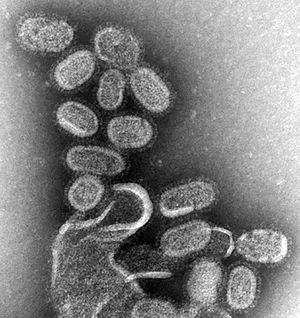Pathogen facts for kids
A pathogen is a tiny living thing that can make you sick. These include viruses, bacteria, fungi, and parasites. When a pathogen causes a disease, it means it has pathogenicity.
Your body has amazing ways to fight off many common pathogens. Your immune system is like a shield, protecting you. Also, "good" bacteria live in your body and help keep you healthy. They stop harmful pathogens from growing too much.
But sometimes, your immune system or these good bacteria can get weaker. This might happen if you are taking certain medicines, like antibiotics. If your defenses are down, pathogens that were being held back can grow and cause problems. These are called opportunistic infections.
Contents
What Are Pathogens?
Pathogens are microscopic organisms that cause diseases. They can be found everywhere, in the air, water, and even on surfaces. When they enter your body, they can multiply and damage your cells. This leads to you feeling unwell.
Types of Pathogens
There are several main types of pathogens. Each type works differently to cause illness.
Viruses
Viruses are the smallest type of pathogen. They are not truly alive on their own. Instead, they need to enter your body's cells to make copies of themselves. Examples include the flu virus and the common cold virus.
Bacteria
Bacteria are single-celled organisms. Most bacteria are harmless, and many are even helpful. But some bacteria can cause diseases like strep throat or food poisoning. Your body's good bacteria help fight these bad ones.
Fungi
Fungi are organisms like molds and yeasts. Some fungi can cause infections, especially on the skin or in the lungs. Athlete's foot is a common fungal infection.
Parasites
Parasites are organisms that live on or inside another living thing. They get their food from their host. Examples include worms and some tiny organisms that cause malaria.
Pathogens and Epidemics
Some pathogens can cause very large outbreaks of disease. When a disease spreads quickly to many people in a region, it's called an epidemic. If it spreads across many countries or even the world, it's a pandemic.
Famous Epidemics
History has seen some very serious epidemics caused by pathogens. These events affected huge numbers of people.
The Black Death
The bacterium Yersinia pestis caused the Black Death. This terrible disease spread across Europe in the 1300s. It killed millions of people.
The Spanish Flu
One of the most famous and deadly pandemics was the 1918 Spanish flu. This was a type of influenza virus (H1N1 subtype). It lasted from 1918 to 1919.
It's hard to know exactly how many people died, but estimates range from 20 to 100 million. Many people say it was "the greatest medical disaster in history." It might have killed as many people as the Black Death.
The Spanish flu spread very easily. Up to half the population got sick. The symptoms were also very severe. People often had bleeding from their nose, stomach, or intestines. Many deaths were from bacterial pneumonia. This was a secondary infection that happened after the flu weakened the body. The virus also directly caused severe bleeding and swelling in the lungs.
Pathogens in Plants
Pathogens don't just affect humans and animals. They can also cause diseases in plants. In plants, fungi are the main cause of infectious diseases. They can damage crops and trees.
Images for kids
See also
 In Spanish: Agente biológico patógeno para niños
In Spanish: Agente biológico patógeno para niños






